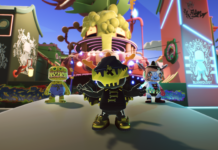GZ: Why do you refer to them as archetypes rather than characters?
Caley Smyth: Everyone will be able to build their own outlaw. So what happens at the beginning of the game is you go in, you select your archetype, customize the colors, and that’s all you’ll be able to do at the beginning. But then we have a reputation point system. You get points for kills, assists, damage, stuff like that. We’re also working on the idea of being able to wager. You’ll be able to wager your reputation points against someone.
There’s character investment in the sense that you can customize them, you can upgrade them as you get reputation points, but we also want you to be able to lose points. It’s something we liked about a lot of the games we grew up playing, and it’s kind of disappearing.
GZ: A lot of games now are all about progression and getting more and more and it starts to feel like a grind.
Caley Smyth: Yeah, you see that with a lot of big companies and big titles, because they want to keep people happy, they don’t want to disappoint them. Luckily, we’re in a situation where a lot of us doing this game, we did it because it was our chance to do something creative. So we can take that risk because we’re a small indie company. It’s not a big deal if we only sell 200,000 units, we don’t have to sell 4 million to break even.
GZ: So you can afford to go for a niche audience.
Caley Smyth: Yeah, I mean, it’s all right here. It’s a spaghetti western, it isn’t just the typical military shooter. It’s highly stylized, which is one more removal from the normal stream. Then we made it multiplayer only. We really wanted to tool it toward skill too.

GZ: Where can we expect to see this game?
Caley Smyth: We really want to get it on PC, on Steam, there’s a lot of demand for that. Right now, we’re an indie developer and so this is all console. Right now we’re in talks with some publishers like Microsoft and some others and we don’t know what’s going to come out of it. We are for sure going to be on the Xbox or the Playstation, but hopefully both.
GZ: Did you consider anything like the Vita? It seems to be a hot spot for indie games at the moment.
Caley Smyth: It wasn’t something we considered, because really, we’re so small that we need a big audience. One thing we really want to do is push content out after it releases. We love the Team Fortress model, they just keep people involved and keep them in there. That’s what we want. We want people to keep playing.
GZ: That kind of support seems trickier to do on something like the Xbox, no?
Caley Smyth: Yeah, exactly. I don’t want to tell people that this is how it’s going to be, that we’re going to have free content, because we don’t know. That stuff is still to be determined, but that’s what we want to do. Even if we end up with Microsoft only, we’re still going to do our best. If we’re going to do content then we’re going to do big packs then, for very little money.
GZ: So what’s the release date you’re aiming for?
Caley Smyth: We really want to get it out before Summer. 2013 for sure. It’s close, we’re really just fine tuning stuff right now. It’ll definitely be out on a console, but we want a PC version too.
If you like to read the latest movie reviews, or random thoughts about whatever is going on in gaming lately, follow me @JoeDonuts!
If you haven’t already heard, Secret Ponchos was one of the bigger indie surprises at PAX East 2013. The game offers up fun, strategic, and twitchy shootout combat with a variety of characters to choose from and a focus on pure competitive multiplayer. I had a chance to speak with Caley Smyth, UI developer at Switchblade Monkeys, about the game’s features and ambitions.
GZ: How did the idea for Secret Ponchos develop?
Caley Smyth: Well we really wanted to make a spaghetti western game, and the initial thing you think of with that is a shooter. Spaghetti Westerns are all about dueling, right? We started with the camera right behind the guy like in Dead Space or something like that. Just on a whim, because we love League of Legends, we love MOBAs, we don’t want to emulate these games but we felt like there was something missing and something different. So we brought the camera up and we realized it really changes the dynamic of the game. It became something really active. A lot of things happened. The environment suddenly became part of the equation. It became really fun to move your guy around the environment and run around.
We’re also Street Fighter fans, we love the fighting mechanic of Street Fighter, it’s so finely tuned. That’s important because our whole game is based on the concept of dueling. So we tried to tie in the fact that we had this game where the combat is really responsive and works well with the controller. You compare that to MOBA games, and if you put a MOBA on a console it’s not really responsive. They’re more about micromanagement, right? We wanted to avoid that, we wanted an in-the-moment combat game. But I think we managed to create something totally unique.

GZ: Tell us about Switchblade Monkeys
Caley Smyth: Our team comes from a really experienced background. We have ex-Blizzard, ex-Radical, lots of industry experience here. Our art director has worked on DC properties and Transformers, so the team is no rookie team.
We thought the game would take like, one year. But what happened was one person would do such a good job that someone else in the process had to do a good job, and then the next guy had to spend even more time.
GZ: So it’s becoming a much more ambitious game?
Caley Smyth: Exactly. It’s way better than we thought it would be. We thought we were making this super-casual game, but then we changed the camera and that changed everything. We started working on the characters and that introduced more ideas like different range mechanics, different fire rates, and then we added power-ups — it just kept spiraling.
GZ: What kind of modes will you have?
Caley Smyth: There’s one vs. one, two vs. two, four vs. four, and then free-for-all. We really like teamplay because with these environments there’s a lot of strategy, and with a team you can really see it happen. There’s a custom mode too where people will be able to set their own rules.
For the demo here we wanted to have a time limit and respawning. In the team modes there’s no time limit, it’s over when you’re dead.

GZ: So it’s like an elimination gametype?
Caley Smyth: Oh yeah. All of a sudden you can be the only guy left and that’s awesome. The scariest thing is when suddenly your team is gone and you’ve got three guys hunting you.
GZ: What’s going on with this cast of characters?
Caley Smyth: We have six archetypes. We have this matador character, and she doesn’t even have a gun. She just has to get in and out quick, but when she gets in she has all these super cool moves. We have Poncho, who has a whip and a short-range shotgun. He has these moves where he whips you and pulls you in to shoot you with his shotgun all in the span of a second. Kid Red is fast, he can hide behind cover and play more sneaky. Then there are other characters that are so slow that the sneakiness just isn’t worth it. Like Gordo, he’s like your Heavy in Team Fortress. He just spams bullets, they don’t do a ton of damage, but if you’re in a team game he’s the guy you want out there providing cover fire.










